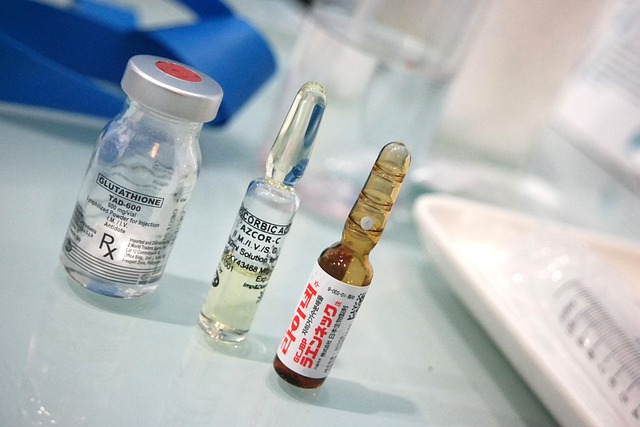Semaglutide, an effective GLP-1 receptor agonist, offers a convenient weekly injectable form for type 2 diabetes and weight management, mimicking natural hormone actions. While common injection site reactions (ISRs) range from mild to severe, proper monitoring and management are crucial. Healthcare providers should guide patients on recognizing symptoms, rotating injection sites, using sterile techniques, and minimizing irritation. Long-term monitoring during regular follow-ups detects persistent issues early. Patient education on ISRs, including normal inflammatory responses, reduces anxiety and promotes treatment adherence.
Injection site reactions are a common concern with semaglutide therapy, but proper management can ensure optimal patient outcomes. This comprehensive guide explores the various aspects of dealing with these reactions, focusing on the unique properties of semaglutide’s injectable form. From understanding the drug and its administration to recognizing and treating symptoms, we cover best practices for healthcare providers and strategies to educate patients, ensuring effective navigation of potential side effects.
Understanding Semaglutide and its Injectable Form

Semaglutide, a glucagon-like peptide-1 (GLP-1) receptor agonist, has gained significant attention in diabetes management due to its unique properties. Its injectable form offers a novel approach to treating type 2 diabetes and weight management. This medication mimics the natural hormone GLP-1, which is produced in the intestine in response to food. By mimicking this hormone’s action, semaglutide helps regulate blood sugar levels, stimulates insulin release, and slows down glucagon secretion, ultimately leading to improved glycemic control.
The injectable form of semaglutide is administered once weekly, providing a convenient and effective treatment option for patients. This formulation is carefully designed to ensure the drug’s stability and efficacy. It is typically delivered via subcutaneous injection, allowing for easy administration at home, which can improve patient adherence to their treatment regimen. Understanding the mechanics of this injectable form is crucial in managing potential side effects, such as injection site reactions, ensuring patients receive the full benefits of this revolutionary diabetes management tool.
Common Injection Site Reactions

Injection site reactions (ISRs) are a common occurrence, especially with the increasing use of injectable medications like semaglutide in its various forms. These reactions can range from mild to severe and typically manifest as local responses at the injection site. The most frequent ISR is erythema, or skin redness, which is usually temporary and resolves on its own within a few days. Pruritus, or itching, is another common reaction, often accompanied by swelling.
More pronounced ISRs include pain, warmth, and induration (hardening of the skin). In some cases, patients may experience more severe reactions such as fever, nausea, or even anaphylaxis. Understanding these potential reactions is crucial for both healthcare providers and patients using semaglutide injectable forms to ensure proper management and minimal disruption in treatment regimens.
Identifying Mild to Moderate Reactions

Mild to moderate reactions to semaglutide, a popular injectable form of medication, can be easily identified and managed. These reactions typically include local symptoms such as redness, swelling, itching, or pain at the injection site. It is crucial to assess the intensity and duration of these symptoms to determine their severity.
Health professionals should encourage patients to monitor their injection sites regularly. Patients can recognize mild reactions by observing localized discomfort, which may subside within a few days. Moderate reactions might involve more significant swelling, redness, or pain that persists for a longer period. Prompt recognition is essential, as it allows for timely intervention and ensures patients receive appropriate care for these manageable yet noticeable side effects.
Managing Severe Reaction Symptoms

In the event of a severe reaction to semaglutide, the first step in management is to assess and address the symptoms promptly. As semaglutide is an injectable form of medication, any acute reactions should be treated with urgency, especially if they involve swelling, itching, or difficulty breathing. The individual should be monitored closely for vital signs stability and any signs of anaphylaxis. Administering adrenaline (epinephrine) can be a life-saving measure in such critical situations, and medical professionals should be immediately alerted.
Once the acute phase is under control, further management involves supportive care tailored to the specific symptoms. This may include antihistamines for itching and swelling, corticosteroids for inflammation, or oxygen therapy for respiratory distress. Close observation in a healthcare setting is crucial until the symptoms resolve completely. Patients should also be advised on how to prevent future severe reactions, such as checking medication labels, understanding potential side effects, and knowing when to seek immediate medical attention.
Best Practices for Optimizing Injection Sites

To optimize injection site reactions for semaglutide, a key focus lies in choosing the right location. The abdominal or upper arm areas are ideal as they offer relatively soft tissue and good blood flow, reducing pain and potential complications with each administration. Rotating sites is another best practice to minimize irritation at any single point. This involves changing the injection spot within the chosen area from one session to the next.
Additionally, proper preparation before and after injections significantly enhances patient comfort. Cleaning the skin with alcohol or an antiseptic solution and using a new, sterile needle each time prevents infection. After the procedure, gently pressing on the injection site can help reduce swelling and bruising. Patients should also be educated on recognizing and reporting adverse reactions to healthcare providers promptly, ensuring timely management.
Monitoring Long-term Effects

Monitoring long-term effects is crucial when considering the management of injection site reactions associated with semaglutide, especially in its injectable form. Regular follow-up appointments allow healthcare providers to assess any persistent or emerging issues related to the injection sites. This is particularly important for patients who require frequent administrations, as it helps identify potential patterns and risk factors. By closely monitoring, healthcare professionals can promptly address any adverse reactions, ensuring optimal patient safety and comfort.
Long-term studies have shown that while most reactions are mild and transient, some individuals may experience more severe complications. Therefore, continuous surveillance enables the early detection of such cases, allowing for timely interventions. This proactive approach to managing injection site reactions enhances patient satisfaction and adherence to semaglutide treatment, especially in the management of chronic conditions that rely on this injectable form of medication.
Patient Education and Support Strategies

Patient education plays a pivotal role in managing injection site reactions (ISRs) associated with semaglutide, an injectable form of medication. Healthcare providers should teach patients about the normal inflammatory response that occurs at the injection site and reassure them that ISRs are common and usually resolve on their own. This can help alleviate anxiety and encourage patients to continue their treatment regimen.
Strategic support mechanisms include providing clear instructions on when to seek medical attention, recognizing severe reactions, and offering practical tips for minimizing discomfort during future injections. Encouraging open communication between patients and caregivers fosters a supportive environment, ensuring timely intervention if ISRs persist or worsen.
